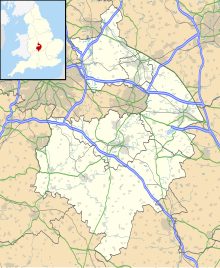
Back معركة إيدجهيل Arabic Bitva u Edgehill Czech Brwydr Edgehill Welsh Schlacht bei Edgehill German Batalla de Edgehill Spanish Bataille d'Edgehill French Cath Edgehill Irish Batalla de Edgehill Galician Battaglia di Edgehill Italian エッジヒルの戦い Japanese
This article needs additional citations for verification. (February 2013) |
| Battle of Edgehill | |||||||
|---|---|---|---|---|---|---|---|
| Part of the First English Civil War | |||||||
 The Prince of Wales and the Duke of York sheltering during the Battle of Edgehill | |||||||
| |||||||
| Belligerents | |||||||
| Royalists | Parliamentarians | ||||||
| Commanders and leaders | |||||||
|
Earl of Essex Lord Feilding | |||||||
| Strength | |||||||
|
| ||||||
| Casualties and losses | |||||||
|
500 killed 1,500 wounded |
500 killed 1,500 wounded[2] | ||||||
Warwickshire | |||||||
The Battle of Edgehill (or Edge Hill) was a pitched battle of the First English Civil War. It was fought near Edge Hill and Kineton in southern Warwickshire on Sunday, 23 October 1642.
All attempts at constitutional compromise between King Charles and Parliament broke down early in 1642. Both the King and Parliament raised large armies to gain their way by force of arms. In October, at his temporary base near Shrewsbury, the King decided to march to London in order to force a decisive confrontation with Parliament's main army, commanded by the Earl of Essex.
Late on 22 October, both armies unexpectedly found the enemy to be close by. The next day, the Royalist army descended from Edge Hill to force battle. After the Parliamentarian artillery opened a cannonade, the Royalists attacked. Both armies consisted mostly of inexperienced and sometimes ill-equipped troops. Many men from both sides fled or fell out to loot enemy baggage, and neither army was able to gain a decisive advantage.
After the battle, the King resumed his march on London, but was not strong enough to overcome the defending militia before Essex's army could reinforce them. The inconclusive result of the Battle of Edgehill prevented either faction from gaining a quick victory in the war, which eventually lasted four years.
